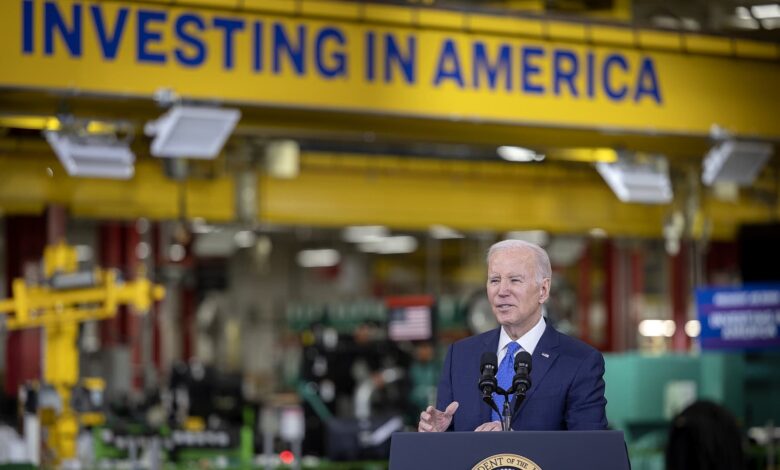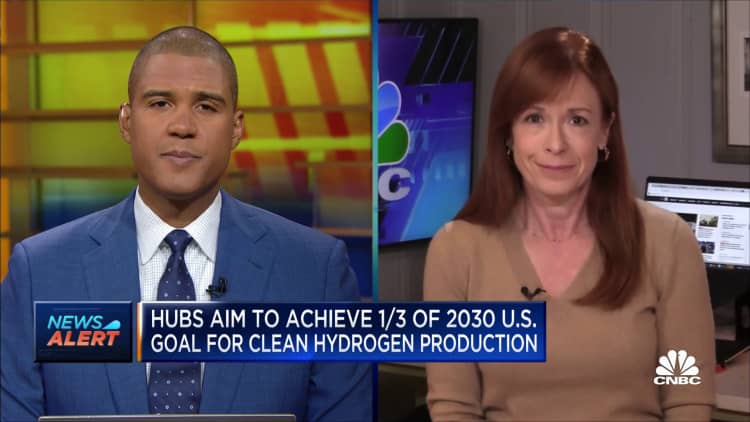Why some ‘clean’ hydrogen hubs in the U.S. plan to use natural gas

President Joe Biden visits the Cummins Power Generation Facility as part of his administration’s Investing in America tour in Fridley, Minn., on Monday, April 3, 2023.
Elizabeth Flores | Star Tribune | Getty Images
President Joe Biden recently approved seven regional hydrogen hubs to receive $7 billion in federal funding intended to spur the development of “clean” hydrogen in the United States. Hydrogen, if produced in a way that does not generate copious greenhouse gas emissions, could be a critical tool to decarbonize some particularly challenging segments of the economy like heavy shipping.
“Clean hydrogen is the Swiss Army Knife of zero-carbon solutions because it can do just about everything: Powering trucks, buses, and airplanes … Heating homes and fertilizing crops … Revolutionizing shipping … And cleaning up America’s manufacturing industry,” Jennifer Granholm, head of the U.S. Department of the Energy, said when she announced the selection of the hubs earlier in October.
Of the seven hubs, two plan to use renewable energy exclusively. The others will use a combination of renewables, nuclear power, and natural gas with carbon capture and storage.
Putting federal money behind a program to fight climate change while using natural gas, a fossil fuel, as one of its main ingredients may not seem intuitive.
Making hydrogen from natural gas with carbon capture — called “blue hydrogen” in the industry — is not necessarily a climate boondoggle, but the only way it’s positive for the climate is with careful execution and ultra-rigorous oversight from the federal government.
“There are methane leakage risks — so climate risks, air pollution risks. So because of that, we were quite disappointed to see such over-reliance on blue hydrogen in the hubs,” Rachel Fakhry, hydrogen policy lead for the Natural Resources Defense Council, said.
“These are hubs that are under direct Department of Energy oversight. So the Department of Energy has a huge, huge role and imperative to require these projects to capture carbon at very high rates, to minimize verifiably methane leakage, to protect against health harms and, yes, you also have some rules around how the carbon capture equipment is powered,” Fakhry told CNBC.
It all depends on how the hydrogen is made
When hydrogen is burned or used in a fuel cell to generate electricity, water is the only byproduct. Generating energy from hydrogen this way does not create carbon dioxide, one of the primary greenhouse gases that causes global warming. Also, hydrogen is a vehicle for storing energy so it can be transported or used later.
Hydrogen in nature mostly exists attached to other atoms, so producing pure hydrogen to use in any of these decarbonization solutions requires splitting molecules. The climate impact of splitting those molecules to produce pure hydrogen varies dramatically.
Hydrogen can be made by splitting water, H2O, with a lot of electricity and a machine called an electrolyzer. If the electricity that goes to power that electrolyzer comes from sources that do not emit any greenhouse gas emissions, like wind turbines or solar farms, then the hydrogen that comes out of the electrolyzer can be beneficial from a climate perspective.
At the same time, making hydrogen with an electrolyzer powered by electricity from coal or other fossil fuels is not “clean” by any metric.
“There have been studies that show that if you run an electrolyzer on grid electricity, you could have more than doubled the carbon intensity of existing gray hydrogen today, depending on where you’re producing it right. If you’re running it off of a grid that doesn’t have clean electricity, then that that wouldn’t be considered clean hydrogen either,” Emily Kent, who leads public policy and education for hydrogen at the nonprofit think tank, the Clean Air Task Force, told CNBC.
Natural gas is also a source of hydrogen. Natural gas is mostly methane, and each methane molecule is one carbon atom bonded to four hydrogen atoms.
Currently, 95% of the hydrogen produced in the United States comes from an energy-intensive process of splitting natural gas with very high-temperature steam, according to the Department of Energy. Making hydrogen this way, called “gray hydrogen” colloquially, releases carbon dioxide emissions that contribute to climate change.
Making lower-carbon hydrogen from natural gas requires, at minimum, using point-source carbon capture technology to scrub the carbon emissions from the factory flues where the steam-methane reforming is happening.
U.S. President Joe Biden, accompanied by Energy Secretary Jennifer Granholm, participates in a tour of the Tioga Marine Terminal in Philadelphia, Pennsylvania, U.S., October 13, 2023.
Jonathan Ernst | Reuters
But how can hydrogen made from natural gas be ‘clean’?
So, how can hydrogen made from natural gas ever be considered “clean”?
First, it’s a question of definitions.
“The word ‘clean’ doesn’t necessarily mean anything. It’s kind of like when you use the word ‘natural’ for foods — it means something different to everyone,” said Kent. “The clearest way to think about it is in terms of carbon intensity or greenhouse gas intensity of the hydrogen production.”
The federal government thinks about hydrogen production in technology-neutral terms, Fakhry says. “So any technology — fossil fuel derived, via electrolysis of water, via biomass — can technically count as ‘clean’ as long as it meets a certain carbon-emissions limit,” Fakhry says.
To wit, the Bipartisan Infrastructure Law, where the funding for the hydrogen hubs comes from, specifically required that two of the selected hydrogen hubs be located in natural gas-rich regions. (It also said that one hub must use fossil fuels with carbon capture, one must use nuclear energy and a third must use renewable energy.)
Calculating the carbon intensity for hydrogen made from natural gas is complicated and will be slightly different depending on which specific project is being considered. But generally, to make low-carbon hydrogen from natural gas, there must be high rates of carbon capture, limited upstream methane leaks in the natural gas supply chain, and the source of the electricity used in the carbon capture process needs to be low or zero carbon, says Kent, says Kent.
“Minimizing the emissions across those three key areas can result in low-carbon hydrogen coming from natural gas,” Kent told CNBC.
Making hydrogen from natural gas with carbon capture will require additional energy and be more expensive than producing hydrogen from natural gas where the excess carbon emissions just spew into the atmosphere. But it is possible.
And Sean Heinroth, principal at Ernst & Young’s EY-Parthenon practice headquartered in Houston, gave CNBC a brief outline of how hydrogen can be produced with natural gas in a way that could be a carbon-neutral process:
- Steam-methane reforming without carbon capture (gray hydrogen) requires about 6.2 megawatt-hours of heat energy to produce 1,120 kilograms of hydrogen.
- Capturing 70% of the carbon emissions (blue hydrogen) associated with making that same quantity of 1,120 kg of hydrogen requires about 10.2 MWh of heat energy while capturing 3.6 tons of carbon dioxide.
- Therefore, making blue hydrogen and capturing 70% of the emissions takes about an additional 4 MWh per 1,120 kg of hydrogen produced. That’s nearly a 40% increase in the energy needed.
But that extra energy requirement does not necessarily mean more CO2 will be generated. That’s because some of the hydrogen made in the steam-methane reforming process can be used to power the point source carbon capture.
“Once the process of producing blue hydrogen starts, it essentially becomes a closed loop process and becomes carbon neutral, because the hydrogen produced is used to power the carbon capture technology,” Heinroth told CNBC.
While all this is possible, it may never happen at scale.
“Currently, blue hydrogen is produced at a very small scale in the U.S.,” Heinroth told CNBC.
That is what the U.S. government is trying to change with its hydrogen hubs program and the production tax credit. Such a process will take time, says Heinroth.
“In the context again of the federal government, if you can ensure that projects have a very high share of carbon capture — so projects are capturing at least 90% of their carbon — and that they are verifiably minimizing their methane leakage to less than 1% — much less than 1% actually, and putting in place some safeguards to minimize air pollution and health harms, then technically, that is a project that could have some climate bona fides,” Fakhry said.
“But the question remains, will projects actually be required to achieve those high standards?” Fakhry said.
Hydrogen hubs will have to verify their emissions to keep their funding
The money that Department of Energy awarded the seven hubs is not delivered in an upfront check.
The $925 million that the Heartland Hydrogen Hub was awarded, for instance, is not a direct payment, Tom Oakland, energy research and development manager at the North Dakota Department of Commerce, told CNBC. The money from the federal government will be dispersed as reimbursements for the projects as they are constructed over time, Oakland told CNBC.
The Heartland Hydrogen Hub — which will include Montana, North Dakota, Minnesota and Wisconsin — is committed to spending $3 for every $1 in federal funding it receives.
“3 to 1 is pretty substantial. You’re getting 25% off, but it’s not like it’s just free money. They’ve got to make a substantial investment on their own,” Oakland told CNBC.
The hydrogen hubs are in the very early planning stages, and at each stage, they will have to prove their legitimacy, says Alex Kizer, a senior vice president at the Washington-based nonprofit energy transition policy shop, the EFI Foundation.
“At each phase, you’re going to need to meet certain technical, economic, and community benefits requirements in order to receive that funding. And one of those technical requirements is your emissions profile,” Kizer told CNBC in a phone call on Monday. “If a project is to receive the early-stage funding from the Department of Energy under phase one, it’s going to need to prove … that it can meet and comply with these requirements, or, in my estimation, it will not receive future funding.”
Testing the technical feasibility and economic viability of various pathways of producing low-carbon intensity hydrogen is a worthy endeavor for the U.S. right now, says Kizer.
“It’s so important that hubs be available to evaluate and demonstrate all of these different options, because in our estimation, there isn’t one way to produce hydrogen in a clean way. That doesn’t mean that all pathways are created equal, but having the hubs with these regional components with these different technologies, exploring these various configurations is so important for us to move up the learning curve on what our clean hydrogen future is,” Kizer told CNBC.
But along the way, Fakhry and other climate-focused watchdog organizations are going to keep pressing the Department of Energy to be more transparent than it’s been so far.
“There is a lack of information. The Department of Energy has not shared much throughout this process, so moving forward, we absolutely need a step-up in information sharing and transparency, especially as these projects start shaping up,” Fakhry. “It is very important for the public to have a say in it, for communities to have a say in it who will live by these projects, but also for civil society writ large, to have a say in how these large public funds are going to be spent on projects.”
“One of our top priorities moving forward with several of our partners is to prod the Department of Energy, prod the hydrogen hub administrators into far more information sharing,” Fakhry said.
Another tool in the federal government’s toolbox to shape the growth of the clean hydrogen industry in the U.S. is the hydrogen production tax credit, 45V, which was included in the Inflation Reduction Act.
How that tax credit ought to be adjudicated by the Treasury Department is hotly debated. But the implementation of the 45V tax credit, if it is adjudicated with strict guidelines in place, will help spur companies working within the hydrogen hubs to produce low-emissions hydrogen.
If hydrogen is produced without releasing any carbon emissions, the tax credit is maxed out at $3 per kilogram of hydrogen. The tax credit, which is available for 10 years, scales down proportionally based on the quantity of emissions released.
“If the 45V rules are very strict and rigorous, then hydrogen production within those hubs, both blue and electrolytic, will likely have far better climate impacts than very weak rules,” Fakhry told CNBC. “Because projects in the hubs want to tap into a 45V credit too. It’s a very lucrative credit.”





